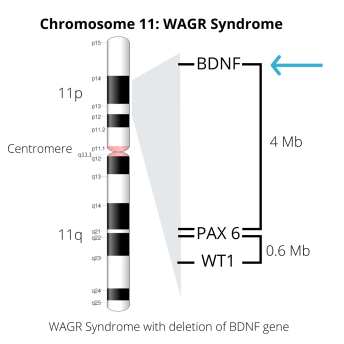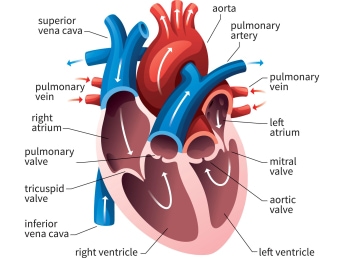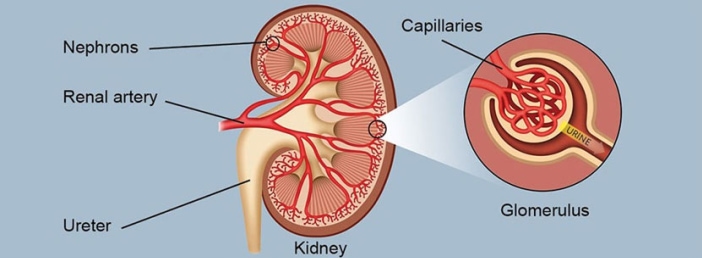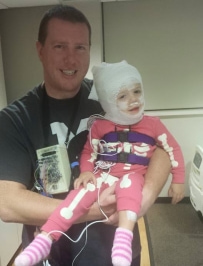In addition to the classic features of Wilms tumor, Aniridia, Genitourinary abnormalities and a Range of developmental delays, other conditions are frequently present in individuals with WAGR syndrome. These conditions are thought to be the result of deleted genes located within or near the WAGR syndrome region of Chromosome 11p13.
The exact size and position of deleted genetic material varies from one individual to another. This may explain why most people with WAGR syndrome have one or more of these conditions but none have all of them.
More than 90 percent of individuals with WAGR syndrome have Auditory Processing Disorder (APD).
APD affects the way the brain receives, organizes, and processes sound. Children and adults with APD usually have normal hearing. But they cannot process the information they hear in the same way as others do. This leads to difficulty recognizing and interpreting sounds, especially sounds involved with speech.
APD may be mild, moderate, or severe. Mild to moderate APD may result in problems following directions or understanding conversation in a noisy environment, such as a classroom or restaurant. Severe APD may interfere with understanding or developing speech.
Early diagnosis and treatment of APD can make a big difference in a child's behavior and ability to communicate and learn.
Learn more about symptoms, diagnosis, and treatment of APD in WAGR syndrome:
Sensory Processing Disorder is a condition in which the brain has trouble receiving and responding to information that comes in through the senses--vision, hearing, touch, taste, smell, balance, and position of the body.
Like many disorders, the symptoms of Sensory Processing Disorder exist on a spectrum. Some people with SPD are overly sensitive to things in their environment. For example:
People with SPD may be physically uncoordinated. They may have difficulty knowing where their limbs are in relation to other people or objects, and may bump into things frequently.
Some people with SPD may be undersensitive to stimulation from their senses or sensory-seeking:
Some people may have a combination of oversensitivity and undersensitivity to sensory stimulation. Knowing your child's symptoms can help you find ways to help him.
Sensory Processing Difficulties: What Are They and How Can Parents Help?
"What is Sensory Processing Disorder?" Learn more about symptoms, diagnosis, and treatment
Deletion of the BDNF gene is present in fifty percent of individuals with WAGR syndrome "BDNF" stands for Brain-Derived Neurotrophic Factor. BDNF is a protein found in the brain and spinal cord. This protein helps with the survival of neurons (nerve cells) and with the development of new ones. BDNF also helps neurons to make synapses, which are communication connections in the brain.
Deletion of the BDNF gene can have a range of effects on an individual. These effects may include:

Genetic testing can determine whether a person with WAGR syndrome has deletion of the BDNF gene. It is important to know if your child is deleted for this gene because it can help you and your child's doctors manage and minimize its effects.
Learn more about the BDNF gene:
Behavioral and psychiatric disorders that may occur in people with WAGR syndrome include:
Learn more about diagnosis and management of behavioral problems and psychiatric disorders in WAGR syndrome:
Congenital (present at birth) heart abnormalities in children with WAGR syndrome may include:

Diagram of a heart
Cardiomyopathy is a disease of the heart muscle that makes it harder for the heart to pump blood to the rest of the body. Individuals with WAGR syndrome who have been treated for Wilms tumor may have received doxorubicin, a chemotherapeutic agent associated with an increased risk for cardiomyopathy. Lifelong monitoring is needed to detect early signs of decreased heart function.
Respiratory problems in individuals with WAGR syndrome may include:
Sixty percent of individuals with WAGR syndrome will develop chronic kidney disease (CKD). Screening for CKD should begin at birth or diagnosis, and consists of laboratory tests, and abdominal and pelvic ultrasound. The goals of screening include:
Learn more about Screening at Birth or Diagnosis here:
Screening Guidelines for Kidney Health throughout the lifespan are available here:
The type of kidney disease associated with WAGR syndrome is called Focal Segmental Glomerulosclerosis or FSGS. Early symptoms of FSGS include:
All individuals with WAGR syndrome are at risk for FSGS, including those who have never had Wilms tumor.
FSGS often progresses to End Stage Renal Failure, a condition that requires dialysis or kidney transplant. Patients with WAGR syndrome and FSGS have successfully received living related donor or cadaver donor kidney transplants
Early diagnosis and appropriate treatment can be effective in slowing the rate of progression of FSGS
Learn more about FSGS:

Diagram of a kidney
Printable Information Sheet
Problems with the head, ears, nose, and throat are common in individuals with WAGR syndrome.
Frequently reported problems include:
Less frequently reported problems include:
Learn more about Potocki-Shaffer syndrome:
Both acute and chronic pancreatitis may occur in individuals with WAGR syndrome.
The risk for pancreatitis is increased if the person has elevated triglycerides (a type of fat in the blood).
Propofol, a medication frequently used in general anesthesia, may increase the risk of acute pancreatitis in patients with WAGR syndrome who also have elevated triglycerides.
Learn more about Pancreatitis in WAGR syndrome:
Gastroesophageal Reflux Disease (GERD) occurs when stomach acid flows back into the tube connecting the mouth and the stomach (esophagus). The backwash of acid reflux can be painful and can irritate the lining of the esophagus. GERD in children with WAGR syndrome can interfere with feeding, and can cause vomiting, gagging, coughing, and trouble breathing. In some cases GERD can lead to reflux of stomach acid into the airways, causing pneumonia.
Learn more about GERD:
Chronic constipation is frequently reported in children and adults with WAGR syndrome. Home treatments include increasing physical activity, fluids, and dietary fiber, and giving prune or pear juice may be helpful in the short term. When these measures are not successful, or when considering the addition of dietary supplements such as probiotics or the use of laxatives, a gastroenterologist (doctor who specializes in disorders of the digestive system) should be consulted.
Less frequently reported:
Metabolic and endocrine abnormalities in WAGR syndrome may include:
Learn more about symptoms, diagnosis, and treatment of dyslipidemia:
Musculoskeletal abnormalities are common in individuals with WAGR syndrome. These abnormalities may include:
Learn more about Potocki-Shaffer syndrome:
Printable Information Sheet (Scoliosis)
Neurologic abnormalities are common in children and adults with WAGR syndrome. These abnormalities may include:
Learn more about symptoms, diagnosis, and treatment of Epilepsy/Seizure Disorder:

Emma undergoing sleep study
Children and adults with WAGR syndrome frequently have difficulties with sleep. These difficulties may include trouble with:
Sleep disorders in people with WAGR syndrome may be the result of obstructive sleep apnea, or underdevelopment of the pineal gland, or both.
Obstructive sleep apnea is diagnosed with a sleep study. This test measures oxygen levels in the blood, heart rate, breathing, and leg movements while a person is sleeping. Treatment for obstructive sleep apnea involves use of a Continuous Positive Airway Pressure (CPAP) machine. This machine allows a person to breathe more easily during sleep by increasing the air pressure in the throat so the airway does not collapse.
Underdevelopment of the pineal gland The pineal gland is located in the brain, and produces melatonin, a hormone which helps the body to regulate sleep. Low levels of melatonin can cause disturbances of sleep.
Low levels of melatonin may be treated with melatonin supplements, which can help to improve the onset, duration, and overall quality of sleep in children and adults with WAGR syndrome. Melatonin supplements should be used with the guidance of a physician, and in tandem with good sleep hygiene.
Learn more about sleep hygiene:
Sign up for News & Events
COPYRIGHT© 2025 IWSA / International WAGR Syndrome Association
